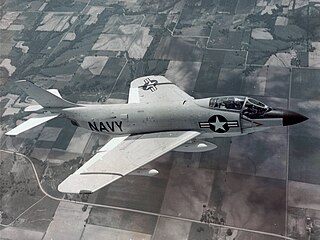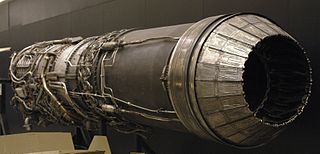
The McDonnell XF-88 Voodoo was a long-range, twinjet fighter aircraft with swept wings designed for the United States Air Force. Although it never entered production, its design was adapted for the subsequent supersonic F-101 Voodoo.

The McDonnell F3H Demon is a subsonic swept-wing carrier-based jet fighter aircraft designed and produced by the American manufacturer McDonnell Aircraft Corporation. It was the first swept wing jet fighter and the only single-engined carrier-based fighter the company produced.

The Douglas A-3 Skywarrior is a jet-powered strategic bomber that was developed and produced by the Douglas Aircraft Company. It was designed by Douglas on behalf of the United States Navy, which sought a carrier-capable strategic bomber. In July 1949, Douglas was awarded the contract to produce its design, having bested eight other aircraft companies' submissions. Unlike rival designs, which had aimed for a 100,000 lb (45,000 kg) maximum take-off weight, the Skywarrior was developed for a 68,000 lb (31,000 kg) take-off weight, facilitating its use from the navy's existing Midway-class aircraft carriers. Large portions of the aircraft were produced by the Westinghouse Electric Corporation, including its early Westinghouse J40 turbojet engines, which failed to meet promises and were replaced by the rival Pratt & Whitney J57 engine by mid-1953. On 28 October 1952, the prototype XA3D-1 performed the type's maiden flight.

An afterburner is an additional combustion component used on some jet engines, mostly those on military supersonic aircraft. Its purpose is to increase thrust, usually for supersonic flight, takeoff, and combat. The afterburning process injects additional fuel into a combustor ("burner") in the jet pipe behind the turbine, "reheating" the exhaust gas. Afterburning significantly increases thrust as an alternative to using a bigger engine with its attendant weight penalty, but at the cost of increased fuel consumption which limits its use to short periods. This aircraft application of "reheat" contrasts with the meaning and implementation of "reheat" applicable to gas turbines driving electrical generators and which reduces fuel consumption.

The Douglas F4D Skyray is an American carrier-based supersonic fighter/interceptor designed and produced by the Douglas Aircraft Company. It was the first naval fighter to exceed the speed of sound in level flight and the last fighter produced by the Douglas Aircraft Company prior to its merger with McDonnell Aircraft to become McDonnell Douglas.

The Douglas F5D Skylancer is a development of the F4D Skyray jet fighter for the United States Navy. Starting out as the F4D-2N, an all-weather version of the Skyray, the design was soon modified to take full advantage of the extra thrust of the Pratt & Whitney J57 eventually fitted to the Skyray instead of the Westinghouse J40 originally planned.

The Vought F7U Cutlass is a United States Navy carrier-based jet fighter and fighter-bomber designed and produced by the aircraft manufacturer Chance Vought. It was the first tailless production fighter in the United States as well as the Navy's first jet equipped with swept wings and the first to be designed with afterburners.

The General Electric J79 is an axial-flow turbojet engine built for use in a variety of fighter and bomber aircraft and a supersonic cruise missile. The J79 was produced by General Electric Aircraft Engines in the United States, and under license by several other companies worldwide. Among its major uses was the Lockheed F-104 Starfighter, Convair B-58 Hustler, McDonnell Douglas F-4 Phantom II, North American A-5 Vigilante and IAI Kfir.

The Grumman XF10F Jaguar was a prototype swing-wing fighter aircraft offered to the United States Navy in the early 1950s. Although it never entered service, its research paved the way toward the later General Dynamics F-111 and Grumman's own F-14 Tomcat.

The General Electric/Allison J35 was the United States Air Force's first axial-flow compressor jet engine. Originally developed by General Electric in parallel with the Whittle-based centrifugal-flow J33, the J35 was a fairly simple turbojet, consisting of an eleven-stage axial-flow compressor and a single-stage turbine. With the afterburner, which most models carried, it produced a thrust of 7,400 lbf (33 kN).

The Rolls-Royce Avon was the first axial flow jet engine designed and produced by Rolls-Royce. Introduced in 1950, the engine went on to become one of their most successful post-World War II engine designs. It was used in a wide variety of aircraft, both military and civilian, as well as versions for stationary and maritime power.

The General Electric J85 is a small single-shaft turbojet engine. Military versions produce up to 3,500 lbf (16 kN) of thrust dry; afterburning variants can reach up to 5,000 lbf (22 kN). The engine, depending upon additional equipment and specific model, weighs from 300 to 500 pounds. It is one of GE's most successful and longest in service military jet engines, with the civilian versions having logged over 16.5 million hours of operation. The United States Air Force plans to continue using the J85 in aircraft through 2040. Civilian models, known as the CJ610, are similar but supplied without an afterburner and are identical to non-afterburning J85 variants, while the CF700 adds a rear-mounted fan for improved fuel economy.

The Lyulka AL-7 was a turbojet designed by Arkhip Mikhailovich Lyulka and produced by his Lyulka design bureau. The engine was produced between 1954 and 1970.

The Vought F6U Pirate was the Vought company's first jet fighter, designed for the United States Navy during the mid-1940s. Although pioneering the use of turbojet power as the first naval fighter with an afterburner and composite material construction, the aircraft proved to be underpowered and was judged unsuitable for combat. None were ever issued to operational squadrons and they were relegated to development, training, and test roles before they were withdrawn from service in 1950.
The Boeing XB-56 was a proposal by Boeing for a re-engined version of the American jet-powered medium bomber aircraft, the B-47 Stratojet. The original designation for this modification was YB-47C.

The Allison J71 was a single spool turbojet engine, designed and built in the United States. It began development in 1948 as a much modified J35, originally designated J35-A-23.

The Westinghouse J34, company designation Westinghouse 24C, was a turbojet engine developed by Westinghouse Aviation Gas Turbine Division in the late 1940s. Essentially an enlarged version of the earlier Westinghouse J30, the J34 produced 3,000 pounds of thrust, twice as much as the J30. Later models produced as much as 4,900 lb with the addition of an afterburner. It first flew in 1947. The J46 engine was developed as a larger, more powerful version of Westinghouse's J34 engine, about 50% larger.

The Westinghouse J46 is an afterburning turbojet engine developed by the Westinghouse Aviation Gas Turbine Division for the United States Navy in the 1950s. It was primarily employed in powering the Convair F2Y Sea Dart and Vought F7U Cutlass. The engine also powered the land speed-record car known as the Wingfoot Express, designed by Walt Arfons and Tom Green It was intended to power the F3D-3, an improved, swept-wing variant of the Douglas F3D Skyknight, although this airframe was never built.

The Volvo RM8 is a low-bypass afterburning turbofan jet engine developed for the Saab 37 Viggen fighter. An augmented bypass engine was required to give both better fuel consumption at cruise speeds and higher thrust boosting for its short take-off requirement than would be possible using a turbojet. In 1962, the civil Pratt & Whitney JT8D engine, as used for airliners such as the Boeing 727, was chosen as the only engine available which could be modified to meet the Viggen requirements. The RM8 was a licensed-built version of the JT8D, but extensively modified for supersonic speeds, with a Swedish-designed afterburner, and was produced by Svenska Flygmotor.
The Westinghouse Aviation Gas Turbine Division (AGT) was established by Westinghouse Electric Corporation in 1945 to continue the development and production of its gas turbine engines for aircraft propulsion under contract to the US Navy Bureau of Aeronautics. The AGT Division was headquartered in Kansas City, Missouri, where it remained in operation until 1960 when Westinghouse decided to focus on industrial and electric utility gas turbines.



















